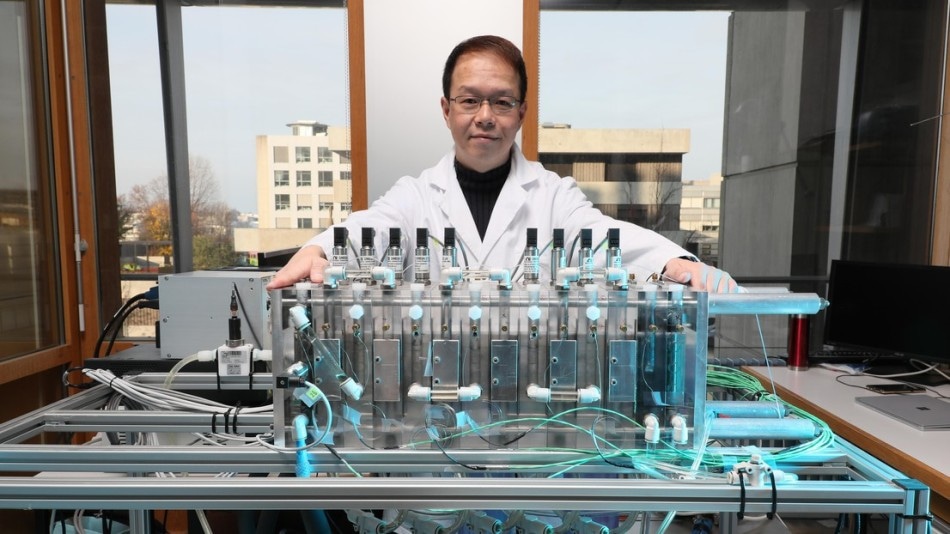Jun 3 2019
People are aware that disproportionate consumption, industrial activity, and growth in the worldwide population are some of the issues threatening access to drinking water for an increasing proportion of people worldwide. According to UNESCO statistics from 2012, nearly 700 million people suffer from inadequate access to water – and that number could grow to 1.8 billion by 2025. Desalination and the treatment of industrial wastewater can generate large quantities of drinking water, and these approaches are already used in a number of nations and regions such as Europe, the United Arab Emirates, China, Saudi Arabia, and the USA. However, current systems are expensive and consume plenty of energy. Jeff Ong, from EPFL’s Laboratory of Inorganic Synthesis and Catalysis, has created a water treatment machine that integrates the advantages of all of the key technologies presently being used while offering enhanced performance. For instance, the prototype eliminates over 99.9% of the salt from seawater with the same throughput but consuming less energy. The system will be tried out in real-world settings this year.
 Jeff Ong. (Image credit: © 2019 EPFL)
Jeff Ong. (Image credit: © 2019 EPFL)
Increasing throughput
The key large-scale desalination technology used currently is reverse osmosis. When two identical liquids divided by a semi-permeable membrane possess a varied concentration of salt or other minerals, the one with the lower concentration passes via the membrane until each liquid contains the same concentration. To reverse this natural process and, thus, maximize the amount of fresh water, pressure is applied to the more concentrated liquid so that it flows via the filtration membrane in the direction of the drinking water side. The method uses a comparatively large amount of electricity (around 4–5 kWh/m3) and the membranes weaken rapidly, as do other components, weakened by mineral particles. They have to be chemically cleaned numerous times each year and replaced very often. “That results in high maintenance costs for producers,” says Ong. However, the desalination idea used by the EPFL spin-off use membranes composed of inert hydrophobic material, wear out less rapidly and can be recycled economically.
Evaporating water using heat recovery elements
In order to maximize salt separation, which the EPFL prototype increases to over 99.9%, Ong designed a series of evaporation-based desalination modules. To look into the system’s key weakness – energy consumption – he made numerous enhancements such as internal heat recovery and more efficient heat transfer. By decreasing the pressure, the water can be made to reach a boil at a temperature below 80 °C. The vapor generated is cooled and recovered as fresh water. The rest of the liquid, which has the remaining salt, moves into another cell with even lower pressure, and so forth. Heat recovery elements are used to pre-heat and vaporize the remaining saltwater, without consuming any energy from outside the system. At each stage, the vapor created is cooled and fresh water is recovered. The fresh water is taken out using heat exchanger devices that are situated so as to cool the system. By reusing heat that would else be lost, E-METS has a much lower carbon footprint compared to a conventional thermal system. “These evaporation and cooling flow principles are commonly employed in the nuclear power industry”, explains Ong. “We are the first to apply the concept in the water separation field.”
Treating very salty water
Latest improvements in this hybrid prototype have also brought about time savings, because throughput is currently up to twice as high as that of reverse osmosis systems. Furthermore, the new system has the benefit of being able to endure very high salt concentrations – over 200 g/L – which is twice as much as regular thermal separation technologies and over four times as much as reverse osmosis. This kind of high salt concentrations can be found, for instance, in the waste solutions generated by reverse-osmosis plants.
Commercial desalination is projected to be worth $27.4 billion in 2025, with the water and water treatment market, on the whole, worth $675 billion. The start-up, Aqualife Global, is presently used to commercialize the E-METS technology. The system’s modular arrangement means that it can be modified to the amount of water to be treated. This year, the co-founders plan to design a version that fits into a shipping container, making it easy to transport and enabling it to be installed where it is most necessary. Besides being used to desalinate seawater, the system can be linked to reverse osmosis plants, helping them to create higher volumes of desalinated drinking water. The co-founders also see a number of other possible applications, such as treating wastewater from the mining sector – and more particularly for lithium mining – and removing sulfur from wastewater produced by electricity generation companies. The system could also be used to treat wastewater coming out of the agri-food and oil and gas sectors.